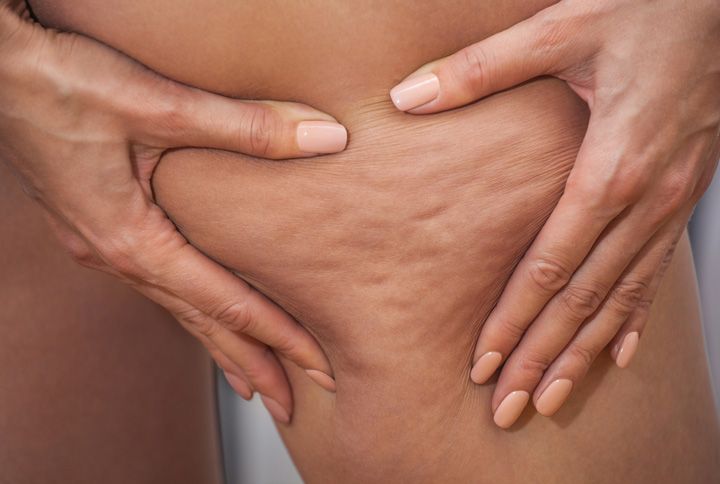
It’s the 21st century, and everyone is accepting their bodies for the way they are. We’re all aggressively practising self-love, whether it’s on the internet or IRL. It’s a-okay to have acne, patchy skin, scars and what not. But there are a few of us who want change and that’s perfectly fine too. From Sonam Kapoor to Eva Longoria and Jeniffer Lopez, they have all admitted to having cellulite and they’re not ashamed about it. If you get bothered by the very dreaded orange peel, youʼre not alone. The desire to get rid of ripped skin that hits our thighs and stomach, or even diminish it, has been in the minds of us all. Not gonna lie, I’ve wanted to get rid of it too. I did quite a bit of research and a lot of asking around until I thought that it would be best to share my knowledge with you. Read on to find out more about cellulite and ways to treat it!
What Is Cellulite?
Cellulite is a term used for the condition in which the skin gets dimpled or has a lumpy appearance. This usually has effects on the buttocks and thighs but can occur in other areas too. Alas, the unfavourable cellulite is more common in females than males, due to the different distributions of muscle, fat and connective tissues. Between 80 to 90 percent of post-adolescence women, such as myself, have a chance of having cellulite at some point in our lives.

What Causes Cellulite?
1. Age and Hormones
Hormones play an important role in the development of cellulite. Insulin, estrogen, thyroid, and prolactin hormones are a part of the production process of cellulite. There are theories stating that when the estrogen in women decreases at the time of menopause, blood flow to the convection tissue decreases too. Age is another factor that causes the skin to loosen, making it thinner and more likely to sag.
2. Genes
There are certain genes that are required for cellulite development. The factors for it can be attached to the distribution of fat under your skin, ethnicity or your speed of metabolism. Sadly, I suffer from low metabolism, hence, I have orange peel skin 😓.
3. Diet and Lifestyle
Even though it is said that toxins do not cause cellulite, a healthy lifestyle may help reduce the risk of it to some extent. Time to say goodbye to junk food because salt, fat, and carbs, basically, less intake of fibre can cause a great amount of cellulite. It may also be prevalent in smokers, those of us who do not exercise, who have excess fat and those who sit in one place for a long period of time. Wearing underwear with tight elastics can also result in cellulite, as they limit the flow of blood.

How To Treat And Remove Cellulite?
To understand a little more about the topic and ways to combat cellulite, we spoke to nutritionist Janvi Chitalia. This is what she had to say:
Cellulite is basic fat deposits that shows around the stomach, hips and thighs which points towards an imbalance in the body. It is seen when the body’s metabolic rate is sluggish it could give rise to cellulite due to cellular levels of inflammation and decreased blood circulation. There are several ways to reduce cellulite through light food choices.
- Turmeric is one food that lowers inflammation and also helps in increasing blood circulation due to its thermogenic properties.
- Omega 3, an imbalance of good fats and bad fats in the body can cause cellulite. Fish oil 1-3 (1000mg), chia seeds 1-2 tbsps soaked, flaxseeds 1-2 tbsps, fish (3 times a week) and walnuts (4-6 halves) per day should be consumed.
- Shredded ginger or dry ginger powder is good to reduce inflammation and improve blood circulation and it also helps with reducing any kind of swelling or bloating in the body .
- Use Vitamin E oil supplementation to be able to improve fat metabolism. Fat soluble vitamins play a role in improving the pathway of fat metabolism. Vitamin (400IU) can be consumed.
- Other dietary sources of Vitamin E are wheat germ oil (1 tbsp), sunflower seeds (100gm or about 1 fistful), almonds (1 fistful or 100g) , peanuts (1-2 fistful) and avocado (1 a day).
- Blueberries and blackberries (1 bowl per day) are high on antioxidants and helps with increasing collagen and renewing skin tissue.
- Lycopene which is present in red and orange coloured fruits and vegetables is high on antioxidants is high on water content which helps to keep the skin hydrated and helps to reverse anti-ageing.
- Avoid high fat foods and high sugar foods to reduce formation of my new cellulite.
- Try dry massages over oil massages, they help the body.Either of these options should be consumed on a daily basis.
If you do not have the time and want quicker results, there are other alternatives to removing cellulite which may cost quite a bit of moolah.
- Acoustic wave therapy uses a device that is hand held to transmit sound waves which may take several sessions.
- Laser treatment can decrease the appearance of cellulite for a year or more which involves inserting a very small laser probe under the skin.
- Subcision is a process where a dermatologist puts a needle under the skin to break up the connective tissue bands. These results can last for 2 or more years.
- Radiotherapy aims to reduce cellulite by heating it, but the results are short-term.
- Ultrasonic liposculpting targets and destroys fat, but research is lacking to show that it works.

Do You Need To See A Doctor?
Cellulite isnʼt a serious medical condition, therefore, treatment isnʼt a necessity. Doctors consider cellulite as a normal occurrence. If you are concerned and worried about the appearance of your skin, you can see your doctor, dermatologist or plastic surgeon, but after all, learn to love your body the way it is!

If you have thoughts or questions on cellulite, let us know in the comments below or come join the conversation at Maliniʼs Girl Tribe on Facebook!

